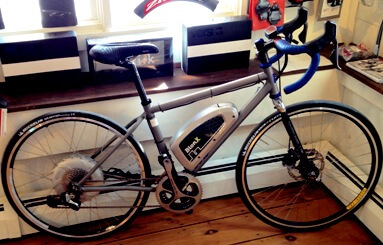Custom Electric Road Bicycle – Guru Praemio Titanium with Bionx S-350DX
Bikes with an electric motor, intended to assist the rider, are very popular in some parts of the world. The e-bike movement is slowly gaining momentum in the United States, and the major manufacturers have started to introduce these bikes. For example, Felt has six e-bike models, three for the road and three for off-road – including a very cool e-Fat Bike. 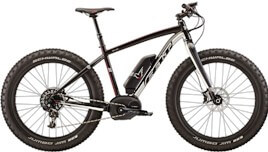 The idea behind an e-bike is to provide a boost to your pedaling, and not to act as a purely electric motor bike. We have converted mountain bikes to e-bikes by adding BionX systems in the past (https://fitwerx.com/index.php?s=BionX), but what about designing a custom electric road bicycle from the ground-up?
The idea behind an e-bike is to provide a boost to your pedaling, and not to act as a purely electric motor bike. We have converted mountain bikes to e-bikes by adding BionX systems in the past (https://fitwerx.com/index.php?s=BionX), but what about designing a custom electric road bicycle from the ground-up?
One drawback of practically all production e-bikes is that they are cruiser-type bikes, designed as city bikes, or rail trail cruisers with flat upright bars. At the moment, there are very, very few “regular” road bikes, with drop bars, manufactured as e-bikes. We have a client who was interested in an e-bike, but one with drop handlebars, i.e. a conventional road bike, but with an electric assist. Our client is not very tall, as evidenced by the fact that her existing bike has 650c wheels. Finally she wanted disc brakes and Di2. If the pickings are few for a road bike with an electric motor, add the requirements of 650c wheel compatibility, hydraulic disc brakes, and electronic shifting, and the pickings are nonexistent. Well, almost nonexistent… Time to get out BikeCad and start creating a bike!
First, we had to decide what electric assist system to use. There are two basic types of e-bike systems. Some e-bikes have the motor built into the rear wheel, called rear drive, while others have a motor that adds its assist at the crank, called a mid-drive. Mid-drive systems are only available as original equipment on bicycles, as they have to be designed to operate the crankset and are built into the frame. Mid-drive simply cannot realistically be added-on to an existing frame – a frame builder would have to design the entire bike around that system. So, after more investigation and discussions with bike manufacturers and our client, it was decided to go with the BionX S350DX, a rear wheel drive system, the same type used on the mountain bike conversions mentioned above. BionX has been in the business of making e-bike systems for over ten years, and they make several models, so they were a good choice.
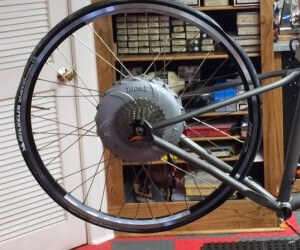 The BionX S350DX features a 350 watt motor with a rechargeable Li-ion battery. The battery pack mounts to the frame’s downtube, taking up the space where one would otherwise mount a water bottle cage. There are 4 separate assist settings, expressed as a percentage of your power output: 37%, 75%, 150%, and 300%. The harder you pedal, the more boost you get, as the boost is a percentage of the power you are putting into the pedal. There is no “accelerator”, meaning that the system cannot act independently of your pedaling. It is not an electric motor scooter. The rechargeable, 48 volt battery has a 65 miles range, using the 37% assist setting. This range is based on a flat ride, no hills, and no increased levels of assist. So a hilly ride, or use of higher power assists, will reduce the mileage.
The BionX S350DX features a 350 watt motor with a rechargeable Li-ion battery. The battery pack mounts to the frame’s downtube, taking up the space where one would otherwise mount a water bottle cage. There are 4 separate assist settings, expressed as a percentage of your power output: 37%, 75%, 150%, and 300%. The harder you pedal, the more boost you get, as the boost is a percentage of the power you are putting into the pedal. There is no “accelerator”, meaning that the system cannot act independently of your pedaling. It is not an electric motor scooter. The rechargeable, 48 volt battery has a 65 miles range, using the 37% assist setting. This range is based on a flat ride, no hills, and no increased levels of assist. So a hilly ride, or use of higher power assists, will reduce the mileage.
The system has the capability for regenerative braking and you can also select a generator mode. For example, you can select this mode on a descent, and the motor acts as a generator, recharging the battery. This helps the range somewhat, but you never get back from what you took out in power while climbing. You could also pedal along the flats in the generator mode, recharging the battery. Doing so is not easy, however, as it takes a lot of energy to spin the rotor in the generator mode. Remember your physics – a generator converts mechanical energy (your pedaling) to electrical energy, so the electrical power going to the battery is directly related to how hard you pedal. For those of us who grew up in the 1960’s, you may remember the headlights lights we put on bikes with a generator that rested against the front tire. Remember how much harder it was to pedal when those primitive generators were engaged? The BionX motor/generator produces far more current than those primitive little things, so the effort to pedal is harder. The bottom line – generator mode is really best left to descending, allowing gravity to provide the energy input.
When it comes to weight, electric motors and powerful batteries are not light. The rear wheel, with the motorized hub, weighed 9 lbs. 14 oz. (4.49 kg), according to the scale in our shop. The battery is another 8 lbs. 9 oz. (3.875 kg). Finally, the handlebar-mounted controller and cabling adds another 1 lbs. 6 oz. (635 grams). So, the entire system weighs 19 lbs, 13 oz., or 9 kg. and then you have to add the weight of the rest of the bike. However, weight becomes irrelevant with up to 350 watts of available electric assist.
When building a custom electric road bike around the electric assist, we had to match a properly-fit frame, disc brakes, and Di2 with internal cable routing and make it all work with the clearance needed for the rear hub. Fit Werx frame designer Bruce Bell worked 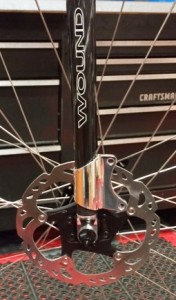 with Josh Novis at Guru Cycles, in Laval, Quebec, outside of Montreal, to arrive at a frame design that would suit our client’s needs, and which would also take into account the design and weight of the BionX system. We used the Guru Praemio model, a full titanium frame made from thin-walled straight gauge 3Al-2.5V titanium tubing. The combination of a strong and durable titanium frame that offered almost unlimited frame geometry options and a plush ride made a lot of sense to base this BionX equipped e-bike. As for the fork, Wound Up produces a carbon fiber fork for 650c wheels and disc brakes, so it was the obvious choice for this bike. These forks offer very good shock and vibration control, while remaining stiff into and out of corners for good handling and responsiveness.
with Josh Novis at Guru Cycles, in Laval, Quebec, outside of Montreal, to arrive at a frame design that would suit our client’s needs, and which would also take into account the design and weight of the BionX system. We used the Guru Praemio model, a full titanium frame made from thin-walled straight gauge 3Al-2.5V titanium tubing. The combination of a strong and durable titanium frame that offered almost unlimited frame geometry options and a plush ride made a lot of sense to base this BionX equipped e-bike. As for the fork, Wound Up produces a carbon fiber fork for 650c wheels and disc brakes, so it was the obvious choice for this bike. These forks offer very good shock and vibration control, while remaining stiff into and out of corners for good handling and responsiveness.
Our client wanted the bike outfitted with a Shimano Dura Ace Di2 drivetrain, coupled with Shimano’s R785 hydraulic disc brakes. As we have said before, this combination of components works exceptionally well, with precise, “goof-proof” shifting, light shifter action, and great braking performance with minimal hand pressure and good modulation. With all that rotating weight in the rear wheel from that electric motor, and the added mass from the battery, the disc brakes help stop this bike much better than rim brakes ever could. We also wanted to equip the bike with an 11-32 rear cassette for easier climbing. To get optimal shifting performance, and avoiding risk of damage to the derailleur or frame, we utilized the K-Edge derailleur conversion on the Dura Ace 9070 Di2 rear derailleur. We have helped with this conversion for many clients (https://fitwerx.com/index.php?s=K-Edge) and it is a high quality solution. The stock short pulley Shimano Dura Ace 9070 Di2 rear derailleur cage was swapped for the K-Edge long cage, and our client will now be able to go up to a 36 tooth cog in the rear if she wishes. These K-Edge derailleur conversions work great, with a very stiff, finely machined pulley cage and we can now do these in-house (K-Edge used to require that we send them in). Finally, Bruce built the front wheel, using a Chris King R45 disc brake hub laced to a Velocity A23 rim, to compliment the rear BionX.
Another challenge came up with the BionX S350DX rear wheel. It will not accept an 11 speed cassette, only 10. A 10 speed cassette, such as Dura Ace 7900, will not work, as the spacing between the individual cogs is different from an 11 speed cassette. So, to make an 11 speed cassette work on the wheel, I simply eliminated the 13 tooth cog, and one spacer. The cassette now goes 11, 12, 14, 16, 18, 20, 22, 25, 28, and 32, but the 11 speed spacing is retained. I then adjusted the derailleur stops to prevent the derailleur from trying to shift to the now non-existent 11th cog. As an aside, this is a simple way to continue to use a rear wheel with only 10 cog capacity on your new 11 speed Shimano system, electronic or mechanical. Just remove one cog and spacer, and adjust the limit screws accordingly.
Building the bike presen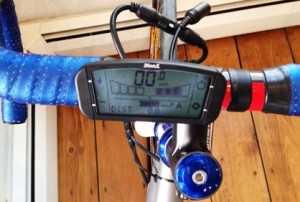 ted a variety of challenges. After all, we were trying to adapt a e-bike system that is designed to be installed on a cruiser or mountain bike, something with a flat handlebar, onto a small sized drop bar road bike. So, for example, the BionX system has small switch that, on a mountain bike, is mounted on the flat handlebar, just inside the hand grip. You can reach it with your thumb, and you can select the level of boost or generation that you want. Unfortunately, there was really no way to mount this so that it would be useable by our client. Plus, it is of a fixed diameter and will not fit around modern crop handlebars. The control screen that mounts on the handlebars thankfully has switches to do the same thing, so nothing was lost but a bit of convenience. Also, there is a switch that is mounted to a mountain bike brake lever, so that when you pull on the brake lever, the BionX system goes into a regenerative braking mode. Again, unfortunately, this could not be mounted on a standard road brake lever, so our client will not be able to take advantage of that feature.
ted a variety of challenges. After all, we were trying to adapt a e-bike system that is designed to be installed on a cruiser or mountain bike, something with a flat handlebar, onto a small sized drop bar road bike. So, for example, the BionX system has small switch that, on a mountain bike, is mounted on the flat handlebar, just inside the hand grip. You can reach it with your thumb, and you can select the level of boost or generation that you want. Unfortunately, there was really no way to mount this so that it would be useable by our client. Plus, it is of a fixed diameter and will not fit around modern crop handlebars. The control screen that mounts on the handlebars thankfully has switches to do the same thing, so nothing was lost but a bit of convenience. Also, there is a switch that is mounted to a mountain bike brake lever, so that when you pull on the brake lever, the BionX system goes into a regenerative braking mode. Again, unfortunately, this could not be mounted on a standard road brake lever, so our client will not be able to take advantage of that feature.
So, how does the custom electric road bicycle all work together? Quite well. With the BionX S350DX system, the bike weighs 35 lbs. 1 oz., or 15.9 kg. This obviously is a far cry from the typical road bike weight of between 16 to 18 pounds (still less than some freeride/DH mountain bikes though…). Be that as it may, riding with the electric motor assist is a blast and she retains all the fit and functionality of her non-electric assist road bike! The power application is very smooth and progressive. There is no clunk, thunk, or jerkiness when it engages, just the seamless application of the desired level of power. Cruising at 10 or 11 mph I did not notice the boost, even when set at 300%, as the system is taking your torque input and multiplying it. So there was probably some subtle boost when cruising slowly, but not much. However, when I accelerated, the bike surged forward at a much faster pace than I expected and I was suddenly cruising at 18 mph with relatively minimal effort. I could easily cruise up hills that I normally have to downshift to the small ring in the big ring. The bike just spins right up! You can really fly on climbs or flats if you engage the 300% “boost”, although the battery will not last super long if you do this all the time.
While much of my test riding of the system was just playing around, the BionX equipped road bike was a hoot to ride and I can see exactly how beneficial this could be to help a rider keep up with others or just be able to continue riding the hills. Used judiciously, only increasing the power when necessary, the system will do a great job allowing its owner to continue to enjoy riding with her husband and continuing to complete longer rides.
Interested in something similar? Interested in something completely different? Contact Us to start the discussion.
Fit Werx, voted “America’s Best Bike Shop”, is an authorized dealer of Guru Bicycles and BionX electric assist systems. With bike shop and fitting locations outside of NYC in Ridgefield Park, NJ, in Peabody and Lexington, MA and near Burlington, VT and Stowe, VT in Waitsfield, Fit Werx is changing the way people buy bicycles through their Rider First Bike Fittings and Rider Matched approach to bike sales. Don’t gamble on your next bike or your fit! Contact us for more information.

